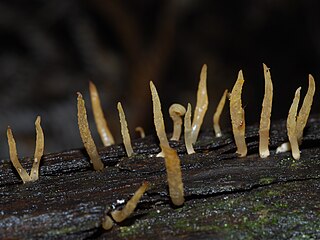
Calocera cornea is a jelly fungus that grows on decaying wood. It is a member of the Dacrymycetales, an order of fungi characterized by their unique "tuning fork" basidia.
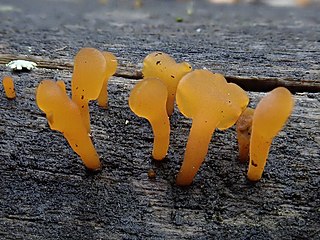
Dacryopinax spathularia is a species of fungus in the family Dacrymycetaceae. Basidiocarps are gelatinous, frequently spathulate (spoon-shaped), and grow on wood, mainly in the tropics and subtropics. The fungus is edible and is commercially cultivated for use as an additive in the food industry.
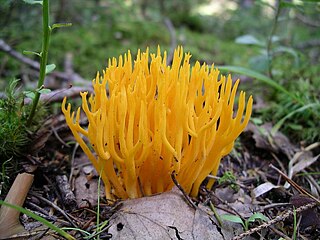
The Dacrymycetes are a class of fungi in the Basidiomycota. The class currently contains the single order Dacrymycetales, with a second proposed order Unilacrymales now treated at the family level. The order contains four families and has a cosmopolitan distribution.

Dacryopinax is a genus of fungi in the family Dacrymycetaceae. The genus is widespread, especially in tropical regions, and contains about 15 species. Dacryopinax was circumscribed by American mycologist George Willard Martin in 1948. A taxonomic monograph was published by McNabb (1965).

Hymenophyton is a genus of the order Pallaviciniales (liverworts) containing one to three species. The genus was formerly described as monotypic, as each member possesses a close morphological resemblance, but phytochemical and molecular evidence now supports an infrageneric classification two separate species. The name Hymenophyton leptopodum, regarded as a synonym of Hymenophyton flabellatum, has been resurrected. A population found in Chile is regarded as a separate clade, and the reinstatement of Hymenophyton pedicellatum has been proposed.
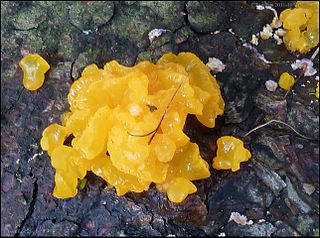
Dacrymyces chrysospermus is a species of jelly fungus in the family Dacrymycetaceae. In the UK it has the recommended English name of orange jelly spot; in North America it is known as orange jelly or orange witch's butter. The species is saprotrophic and grows on dead coniferous wood. Basidiocarps are gelatinous, bright orange, and extremely variable in shape, but typically stoutly stipitate with a spoon- or cup-shaped, spore-bearing head. They are frequently erumpent in groups, often coalescing to form complex masses up to 6 cm (2.4 in) across. Dacrymyces chrysospermus was originally described from New England, but is said to have a worldwide distribution. Microscopically it is distinguished from most other species of Dacrymyces by its comparatively large, 7-septate basidiospores.

Pleurotus purpureo-olivaceus is a gilled fungus native to Australia and New Zealand. It is found on dead wood of Nothofagus trees. Although morphologically similar to some other Pleurotus fungi, it has been shown to be a distinct species incapable of cross-breeding and phylogenetically removed from other species of Pleurotus.

Gliophorus is a genus of agaric fungi in the family Hygrophoraceae. Gliophorus species belong to a group known as waxcaps in English, sometimes also waxy caps in North America or waxgills in New Zealand. In Europe, Gliophorus species are typical of waxcap grasslands, a declining habitat due to changing agricultural practices. As a result, two species, Gliophorus europerplexus and Gliophorus reginae, are of global conservation concern and are listed as "vulnerable" on the IUCN Red List of Threatened Species.

Dacrymyces is a genus of fungi in the family Dacrymycetaceae. Species are saprotrophs and occur on dead wood. Their distribution is worldwide. Basidiocarps are ceraceous to gelatinous, often yellow to orange, and typically disc-shaped to cushion-shaped.
Dacryonaema is a genus of fungi in the order Dacrymycetales. As with other members of the Dacrymycetes, species of Dacryonaema are saprotrophs, occur on dead wood, and have gelatinous basidiocarps. Microscopically all species have clamped hyphae and branched hyphidia.
Ruth Mason was a New Zealand botanist specialising in the taxonomy and ecology of freshwater plants. She was employed at the Department of Scientific and Industrial Research for 35 years undertaking research into aquatic plants, pioneering new techniques for plant preservation and collecting over 13,000 plant specimens in the field. She was awarded life membership by the New Zealand Ecological Society.

Tylopilus brunneus is a bolete fungus of the genus Tylopilus found in New Zealand. It was originally described by Robert Francis Ross McNabb as a species of Porphyrellus in 1967, and transferred to Tylopilus by Carl Wolfe in 1980.
Robert Francis Ross McNabb was a New Zealand mycologist. He was born in Kawakawa, and attended local schools in his youth, including Whangarei Boys' High School and Southland Boys' High School. He received a BSc degree from the University of Otago in 1956, and two years later an MSc for his work on mycorrhizae morphology in native New Zealand plants. In 1961, having been awarded a National Research Fellowship the year before, McNabb left New Zealand for the UK to study with Cecil Terence Ingold at Birkbeck College. McNabb earned a PhD in 1963; his thesis was titled "Taxonomic studies in the Dacrymycetaceae". He was jointly awarded the Hamilton Memorial Prize in 1966 from The Royal Society of New Zealand, the same year he was appointed to the editorial board of the New Zealand Journal of Botany. Most of McNabb's later publications, largely published in this journal, were about fungal taxonomy. Fungus species named in honor of McNabb include Paxillus mcnabbii, and Entoloma mcnabbianum.
Phellodon nothofagi is a species of tooth fungus in the family Bankeraceae. Found in New Zealand, it was described as new to science in 1971 by mycologist Robert Francis Ross McNabb.
Hygrophoropsis coacta is a species of fungus in the family Hygrophoropsidaceae. Described as new to science in 1969 by Robert Francis Ross McNabb, it is found in New Zealand.
Peter Brian Heenan is a New Zealand botanist.
The Unilacrymaceae are a family of fungi in the order Dacrymycetales. The family currently contains the single genus Unilacryma with two known species from Europe, North Asia, and North America. The family was originally placed within its own order, the Unilacrymales, but subsequent research suggests it is better accommodated within the Dacrymycetales.
The Cerinomycetaceae are a family of fungi in the order Dacrymycetales. The family currently contains the single genus Cerinomyces which has a cosmopolitan distribution.
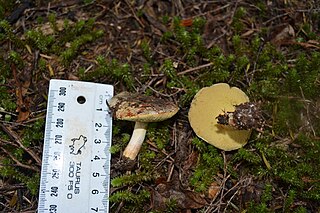
Boletus leptospermi is a fungal species in the family Boletaceae.
Naohidea sebacea is a species of fungus in the order Naohideales. The order is currently monotypic, having only one family, one genus, and one species. Basidiocarps of Naohidea sebacea form small, gelatinous pustules on wood-inhabiting species of Botryosphaeriaceae. Microscopically, they produce long, slender, auricularioid basidia and amygdaliform (almond-shaped) basidiospores.

















